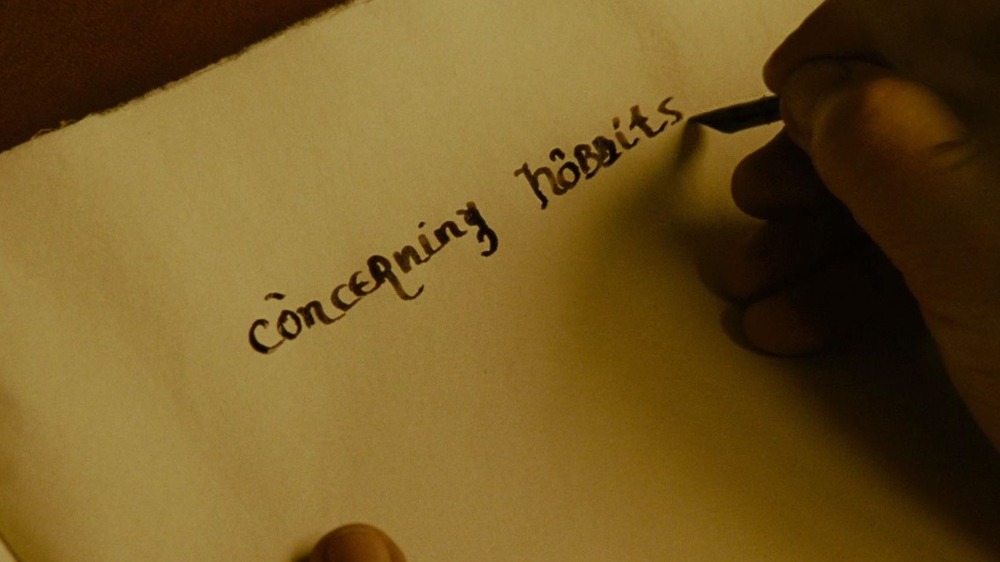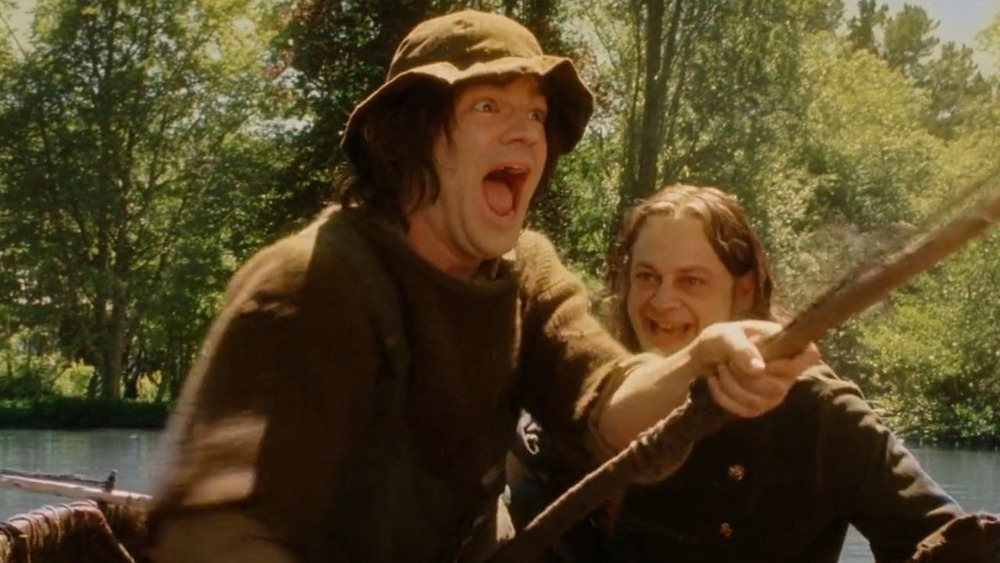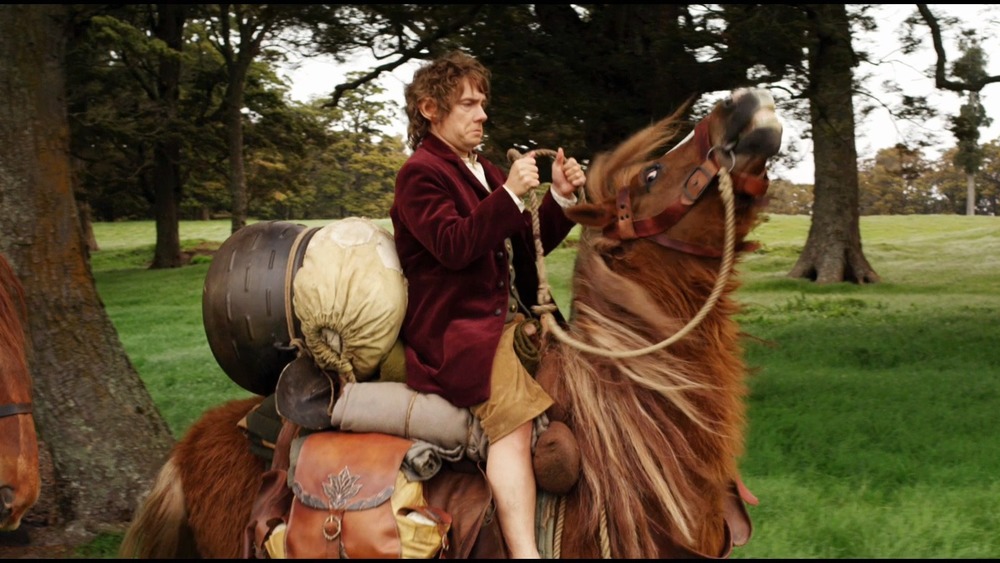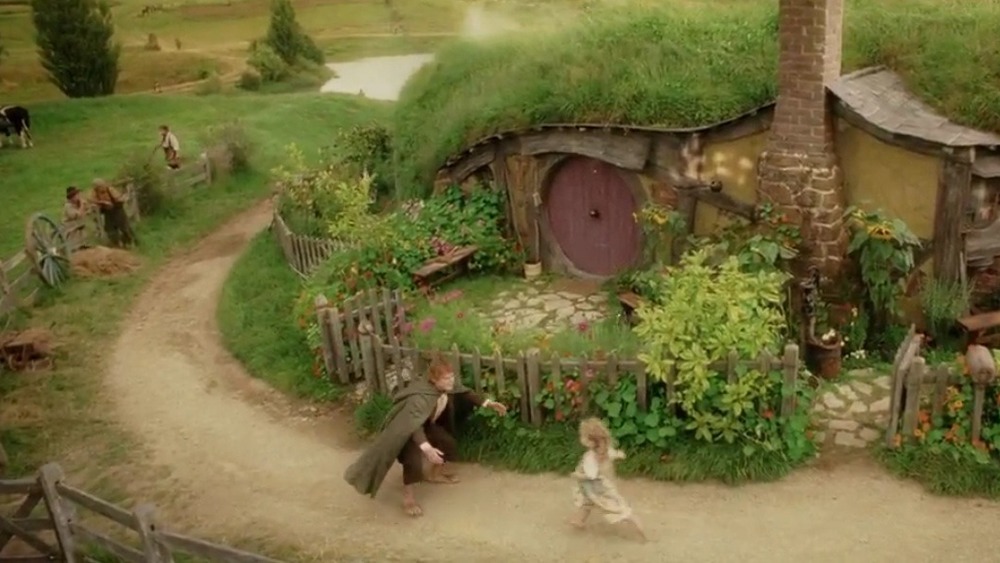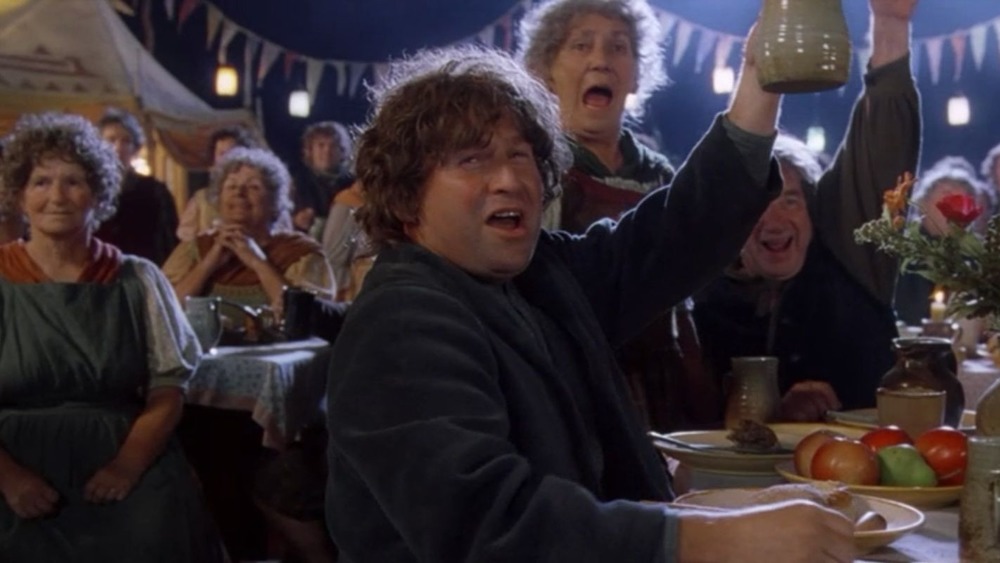The Backstory Of Hobbits Explained
There are many creatures that world-hop from one fantasy story to the next. However, Hobbits are a kindred entirely native to Middle-earth and Middle-earth alone. Though they play a major role in both The Hobbit and The Lord of the Rings, Hobbits weren't a part of Tolkien's world until he penned the line "In a hole in the ground there lived a hobbit" in the summer of 1930 — nearly fifteen years after he started work on his fantasy world.
While Hobbits may have come late and a bit unexpected to the party, Tolkien took them to heart. He considered himself a Hobbit (in all but size) and began building the quiet Little People into the very heart and soul of his world.
This, of course, means the scrupulously detailed author also built in a magnificent backstory for the tiny race and, while it pales in comparison to that of Elves, Dwarves, and Men, Tolkien still provided a decent amount of Hobbit lore for fans of Middle-earth to bask in. Some of this was historical. Other elements were about cultures, habits, language, and family trees.
Regardless of the topic, as with all things Tolkienian, eventually there were enough details about Hobbits to drown a casual reader in information. Even worse, it was spread out across different publications and had to be cobbled back together to make any sense. With that in mind, we've tried to present a sweet-and-condensed version of the backstory of our Hobbit friends by tracing the history of the halflings.
Ready to roll? Let's have some fun with this thing.
(Kind-of) Early Hobbit history
Hobbits don't show up on the scene until relatively far into Middle-earth history. In the prologue to The Fellowship of the Ring, Tolkien states that "It is plain indeed that in spite of later estrangement Hobbits are relatives of [Men]." However, it also adds that the relationship "can no longer be discovered" and that "The beginning of Hobbits lies far back in the Elder Days that are now lost and forgotten." In the über-nerdy book The Peoples of Middle-Earth, Tolkien also states that "In their unrecorded past they must have been a primitive, indeed 'savage' people." However, it also explains that by the time they enter the larger story they've learned many arts and customs from Men.
After uncounted years spent living quietly unnoticed, the earliest Hobbits first pop up on the map in northeastern Middle-earth between the Misty Mountains and Greenwood (later called Mirkwood). This is in the lovely rural area where Beorn the Skin-Changer lives during The Hobbit. It's also where the One Ring is lost in the Great River at the end of the Second Age. As a side note, this explains why Gollum, who is one of these early Hobbits, is living near to the river when the poor wretch kills his friend and makes off with the corrupt piece of jewelry.
This is also the same area that was originally inhabited by the ancient ancestors of the Rohirrim. These Northmen even hobnobbed with Hobbits (or Holbytlan, as they called them) before they migrated south to their new home of Rohan. This is why, when Théoden meets Merry and Pippin in The Two Towers, the King of Rohan explains to them that there are still vague legends among his people that claim that "far away, over many hills and rivers, live the halfling folk that dwell in holes and sand dunes."
The three 'breeds' of Hobbits
In their early days, Hobbits were generally split into three large groups called the Harfoots, the Stoors, and the Fallohides. Each of these are referred to as "breeds," and consist of collections of Hobbits with similar features and interests.
The Harfoots show the most connection with future Hobbit-kind. They're on the smaller side and lack beards and shoes. They have darker skin and are dexterous and nimble-footed. They like to live in the same place for long periods of time, inhabit tunnels and hills, and prefer higher elevations like mountains and hillsides. They live near the Misty Mountains and interact with Dwarves often.
The Stoors are larger-bodied, stocky fellows who have large feet and hands. They like riversides and flatlands. In The Fellowship of the Ring, Gandalf explains to Frodo that he guesses Gollum's people are "of hobbit-kind; akin to the fathers of the fathers of the Stoors," which would explain the proto-Hobbit's affinity for fishing. The Stoors tend to interact with Men more often than their Hobbit brethren.
The Fallohides are tall, slim, and light of hair and skin. They're particularly enamored with woods and trees, and it should come as no surprise that they are associated with Elves the most often. They also love language and songs and show an unusual preference for hunting rather than agriculture.
All three branches of the Hobbit race have their own individual preferences and stories as their recorded history begins. However, as the Third Age begins they eventually sync up in one crucial activity: They all start to migrate west.
Wandering Hobbits
The Hobbits live east of the Misty Mountains for an unknown period of time. However, as the years pass, a few factors begin to change and their circumstances become less desirable. As this happens, the Hobbits begin to attempt the dangerous journey across the Misty Mountains in the hopes of finding a better home in the lands beyond.
Once again we turn to The Fellowship of the Ring prologue for some answers as to what it is that drives them from their eastern homeland. In this case, though, there aren't any hard and fast reasons for this initial Hobbit migration. The source material simply says that "why they later undertook the hard and perilous crossing of the mountains ... is no longer certain." However, the text does follow this up with the note that in their own Hobbit lore they claim that "the multiplying of Men" is a factor. Another motivation likely comes from the fact that a "shadow" falls on the nearby forest — which begins to be called Mirkwood at this point, by the way. This shadow is, of course, Sauron taking a new form. Picking up on their unwelcome new neighbor's presence, the Hobbits probably begin to put some space between themselves and the unseen Dark Lord.
The three groups of Hobbits cross the mountain range at different points, with the Harfoots leading the way and the Stoors coming over last. Once across, they begin fanning out into different areas of the northeastern portion of the continent. This is a centuries-long event called the "Wandering Days." During this time they begin to settle down in new areas, including Bree. They learn how to write from the local Elves and Men and stop speaking their own languages, shifting to Westron (the Common Speech of Middle-earth that is basically English) instead.
Colonizing the Shire
At this point the earliest Hobbits have slowly made their way from right to left across the top of Middle-earth. They crossed the Misty Mountains and creeped across Eriador, learning new customs and creating new settlements along the way. Tolkien explains that all of this activity is distant legend by the time of The Lord of the Rings. However, just over sixteen centuries into the Third Age, myth suddenly becomes fact and formal Hobbit history begins. What happens in that year that's so important? The Hobbits find a new homeland.
After centuries of wandering, in the 1601st year of the Age, two Fallohide brothers named Marcho and Blanco leave Bree with colonization on their minds. They have permission from the local king to find an empty area of his kingdom, and before long they settle on a large area of land that becomes known as the Shire. More and more Hobbits of all kinds join the pair of siblings and their fellow colonists, and before long a large area has been settled.
Technically, the Shire is still part of the local kingdom, but as long as they keep the bridges and roads repaired and acknowledge the monarch as their king, they're allowed to basically rule themselves autonomously. A few hundred years later, the kingdom is destroyed by the Witch-king of Angmar and the Hobbits simply continue ruling themselves (even though they're still technically part of the kingdom when Aragorn becomes king again over a thousand years later). Happy in their new home, the Shire inhabitants quickly sink back into anonymity, virtually disappearing from the records for the next millennium and a half.
Later Hobbit history
On your average day — or even your average year — the Hobbits of the Shire spend their time in peace and plenty. However, there are still several dramatic events that take place during the roughly 1400 years between the beginning of the Shire and the War of the Ring.
For instance, in one of their rare violent moments, the Hobbits send soldiers to help the local king in his struggle with the Witch-king. Much later on, the Shire is invaded by Orcs, and the Hobbits, led by the Hobbit hero Bandobras "Bullroarer" Took, defeat them in the Battle of Greenfields. Bullroarer invents golf at the same time, no less. The only other battle in Shire history is the Battle of Bywater, which involves Frodo, Sam, Merry, and Pippin after they return to the Shire, a scene which was tragically axed from Peter Jackson's cinematic adaptations.
Fighting aside, the Shire also suffers from the "Great Plague" that wrecks all of Middle-earth in the middle of the Third Age. In the few hundred years leading up to The Lord of the Rings the Hobbits also suffer from a pair of unusually terrible winters that lead to famine and an invasion of wolves.
Nevertheless, by the time Bilbo Baggins' story starts, the Shire is once again booming. This is largely because the simple land is hardly a wealthy target for war and conquest and is also protected by the Rangers (unbeknownst to the locals). Even during the War of the Ring, where Hobbits gain great fame as heroes of Middle-earth, the Shire-dwellers remain on the periphery of the story. After the war, they linger on in the world, although the prologue of The Fellowship of the Ring informs us that they are shy of the "Big Folk" (Men) and "avoid us with dismay and are becoming hard to find."

